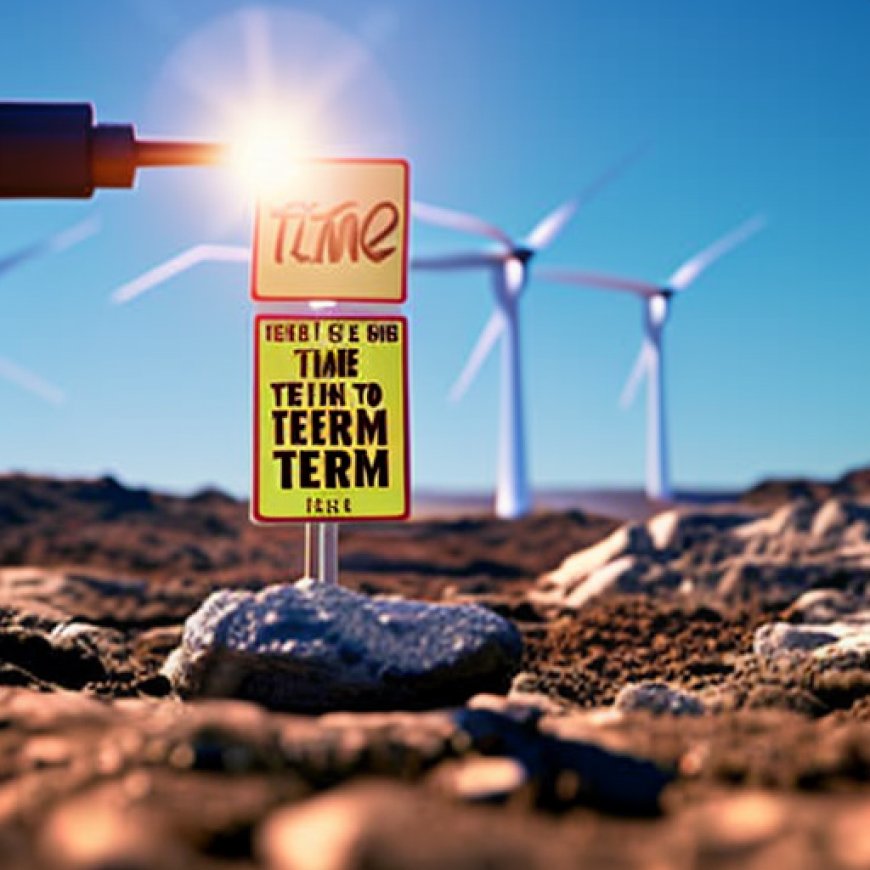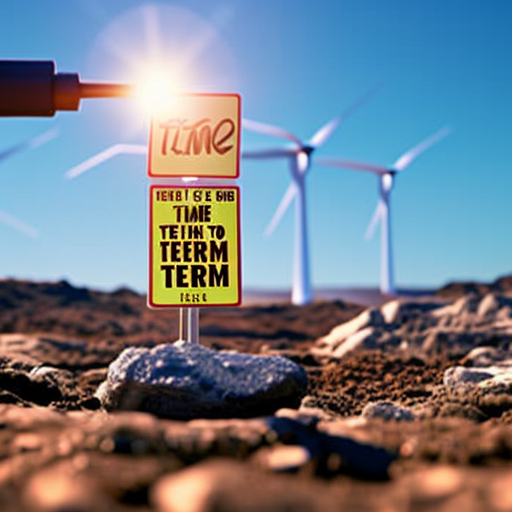Is it Time to Retire the Term “Clean Energy”? – Inside Climate News
Is it Time to Retire the Term “Clean Energy”? InsideClimate News


Clean Energy and Sustainable Development Goals
At a conference this month, a reporter gave a compelling presentation that touched on how many “clean energy” sources depend on supply chains or processes that are far from clean. A lot of the problem is in the mining of metals used in solar panels and lithium-ion batteries, which can devastate the places where they are extracted.
Even though it was first thing in the morning, and I was only a few sips into my first cup of coffee, the presenter, Jael Holzman of Axios, had my attention. After all, I write a newsletter called Inside Clean Energy.
I have heard many versions of the argument that clean energy is dirty because of the need to mine lithium, cobalt and other metals. But it hit me differently coming from a fellow reporter whose work I admire. It made me ask what “clean energy” means and whether it’s a term I should continue to use. (Holzman has written or co-written many stories that touch on environmental concerns related to the rise of clean energy technologies.)
Defining Clean Energy
To be even more specific, when I say “clean energy,” I mean energy sources that emit zero carbon or near-zero carbon at the power plant level and when used by the end consumer. This includes wind, solar, hydro and geothermal power, among others. It also includes nuclear power. Does it include the burning of wood and other biomass? Probably not, but that’s a question whose answer would be a long digression.
I do worry, however, that the term “clean energy” may mean different things to different people to the point that it isn’t useful.
A big point of conflict in this discussion is whether nuclear should be considered clean. There are justified concerns about environmental issues related to uranium mining and disposal of spent nuclear fuel. At the same time, nuclear power plants are one of the world’s leading sources of carbon-free electricity.
Expert Opinions
To get a better sense of what “clean energy” means and whether we should be using the term, I got in touch with two people who spend a lot of time writing and thinking about energy: Catie Hausman, a University of Michigan public policy professor, and Eric Gimon, a senior fellow at the think tank Energy Innovation.
“The idea that we should retire [the term ‘clean energy’] because no energy is totally clean is just ridiculous,” Hausman said.
She said the concerns about environmental damage from mining are important to consider, but they pale in comparison to the damage from extracting, refining and burning fossil fuels.
Gimon, too, views “clean energy” as a useful term, especially for talking about energy with laypeople, and in drawing a contrast between carbon-free energy sources and energy generated from fossil fuels.
But he makes some distinctions. He is OK with using “clean energy” in a conversation, but finds the term less useful when discussing the details of policy, such as which technologies are eligible for government aid. For example, the burning of hydrogen to produce electricity is not something that can easily be categorized as dirty or clean, and requires a deeper examination of the process being used, he said.
Gimon uses the shorthand “clean enough” to explain why some technologies can be described as clean even if they are not 100 percent clean on a lifecycle basis. He thinks a reasonable person can see that generating solar power, for example, is much cleaner than burning coal, even with a thorough accounting of lifecycle emissions.
His larger point is that a fixation on the down side of clean energy technologies is not helpful in the context of a climate crisis.
“We’re fighting for our lives here,” he said.
The word “clean” can be used to obfuscate, like the way that the natural gas industry describes its product as clean, and the generation-long push to promote “clean coal.”
But this isn’t a reason to stop using the term “clean energy,” Hausman said.
“If we were to discard the term ‘clean energy,’ I think that people that want to obfuscate would find another way to leverage whatever term we started to use,” she said. “So I’m going to keep using the term ‘clean,’ and my classes are going to keep having the same discussion about what we mean when we say ‘clean.’”
I’m sympathetic to the view that the term “clean energy” has some shortcomings. I can see how someone who focuses mostly on mining or on issues related to nuclear waste would be uncomfortable using the term.
But I’m not planning to stop saying “clean energy,” at least not yet. As long as the world continues to get a large share of its energy from fossil fuels, which are harmful at almost every point of their lifecycle, “clean energy” is useful as a shorthand, with proper caveats.
What are the caveats? That would be a long list, but I’ll leave you with a big one: No energy source is completely clean.
Other stories about the energy transition to take note of this week:
-
Biden Administration Surpasses Renewable Energy Goal for Public Lands:
The Biden administration said it has reached its goal of approving more than 25 gigawatts of clean energy projects on public lands. The administration also finalized a plan to reduce project fees for wind and solar power on federal land.
-
EV Sales Are Slowing and Tesla’s Sales Are Slumping:
U.S. customers bought or leased about 269,000 electric vehicles in the first three months of this year, which is a 2.6 percent increase from the same period last year, but indicates a slowdown from more recent quarters. The sales figures are in line with what many analysts view as a slowing of EV sales. One big factor in this decrease: Tesla dominates this market and its sales fell in the first quarter compared to the same period last year.
-
Tesla Will Lay Off More Than 10 Percent of Global Workforce:
Amid sagging sales and a falling share price, Tesla said this week that it is cutting about 10 percent of its global workforce. “As we prepare the company for our next phase of growth, it is extremely important to look at every aspect of the company for cost reductions and increasing productivity,” said Tesla CEO Elon Musk in a memo to employees that was obtained by CNBC.
-
SDGs, Targets, and Indicators Analysis 1. Which SDGs are addressed or connected to the issues highlighted in the article?
- SDG 7: Affordable and Clean Energy
- SDG 13: Climate Action
- SDG 15: Life on Land
The article discusses the environmental concerns related to the mining of metals used in clean energy technologies such as solar panels and lithium-ion batteries. These concerns are directly connected to SDG 7, which aims to ensure access to affordable, reliable, sustainable, and modern energy for all. Additionally, the article mentions the need to reduce reliance on fossil fuels, which is a key aspect of SDG 13, which focuses on taking urgent action to combat climate change and its impacts. Lastly, the article highlights the potential environmental damage caused by mining activities, which aligns with SDG 15, which aims to protect, restore, and promote sustainable use of terrestrial ecosystems.
2. What specific targets under those SDGs can be identified based on the article’s content?
- SDG 7.2: Increase substantially the share of renewable energy in the global energy mix
- SDG 13.2: Integrate climate change measures into national policies, strategies, and planning
- SDG 15.9: By 2020, integrate ecosystem and biodiversity values into national and local planning, development processes, poverty reduction strategies, and accounts
The article indirectly addresses these targets by discussing the need for clean energy sources and the environmental concerns associated with mining activities. Increasing the share of renewable energy in the global energy mix (SDG 7.2) is a target that can help mitigate climate change and reduce reliance on fossil fuels. Integrating climate change measures into national policies (SDG 13.2) is crucial for transitioning to clean energy sources and reducing greenhouse gas emissions. Integrating ecosystem and biodiversity values into planning processes (SDG 15.9) is important to ensure sustainable mining practices and minimize environmental damage.
3. Are there any indicators mentioned or implied in the article that can be used to measure progress towards the identified targets?
Yes, the article mentions indicators that can be used to measure progress towards the identified targets:
- Share of renewable energy in the global energy mix: The article discusses the need for clean energy sources such as wind, solar, hydro, geothermal, and nuclear power. The increase in the adoption and capacity of these renewable energy sources can be used as an indicator of progress towards SDG 7.2.
- Integration of climate change measures into national policies: The article highlights the importance of considering environmental concerns related to mining activities in policy discussions. The extent to which climate change measures are integrated into national policies can be used as an indicator of progress towards SDG 13.2.
- Integration of ecosystem and biodiversity values into planning processes: The article mentions the potential environmental damage caused by mining activities and the need to consider ecosystem and biodiversity values in planning. The extent to which these values are integrated into planning processes can be used as an indicator of progress towards SDG 15.9.
Table: SDGs, Targets, and Indicators
SDGs Targets Indicators SDG 7: Affordable and Clean Energy 7.2: Increase substantially the share of renewable energy in the global energy mix Share of renewable energy in the global energy mix SDG 13: Climate Action 13.2: Integrate climate change measures into national policies, strategies, and planning Extent of integration of climate change measures into national policies 13.3: Improve education, awareness-raising, and human and institutional capacity on climate change mitigation, adaptation, impact reduction, and early warning Level of education and awareness on climate change mitigation and adaptation SDG 15: Life on Land 15.9: By 2020, integrate ecosystem and biodiversity values into national and local planning, development processes, poverty reduction strategies, and accounts Extent of integration of ecosystem and biodiversity values into planning processes 15.a: Mobilize and significantly increase financial resources from all sources to conserve and sustainably use biodiversity and ecosystems Amount of financial resources mobilized for biodiversity conservation and sustainable ecosystem use Behold! This splendid article springs forth from the wellspring of knowledge, shaped by a wondrous proprietary AI technology that delved into a vast ocean of data, illuminating the path towards the Sustainable Development Goals. Remember that all rights are reserved by SDG Investors LLC, empowering us to champion progress together.
Source: insideclimatenews.org

Join us, as fellow seekers of change, on a transformative journey at https://sdgtalks.ai/welcome, where you can become a member and actively contribute to shaping a brighter future.







